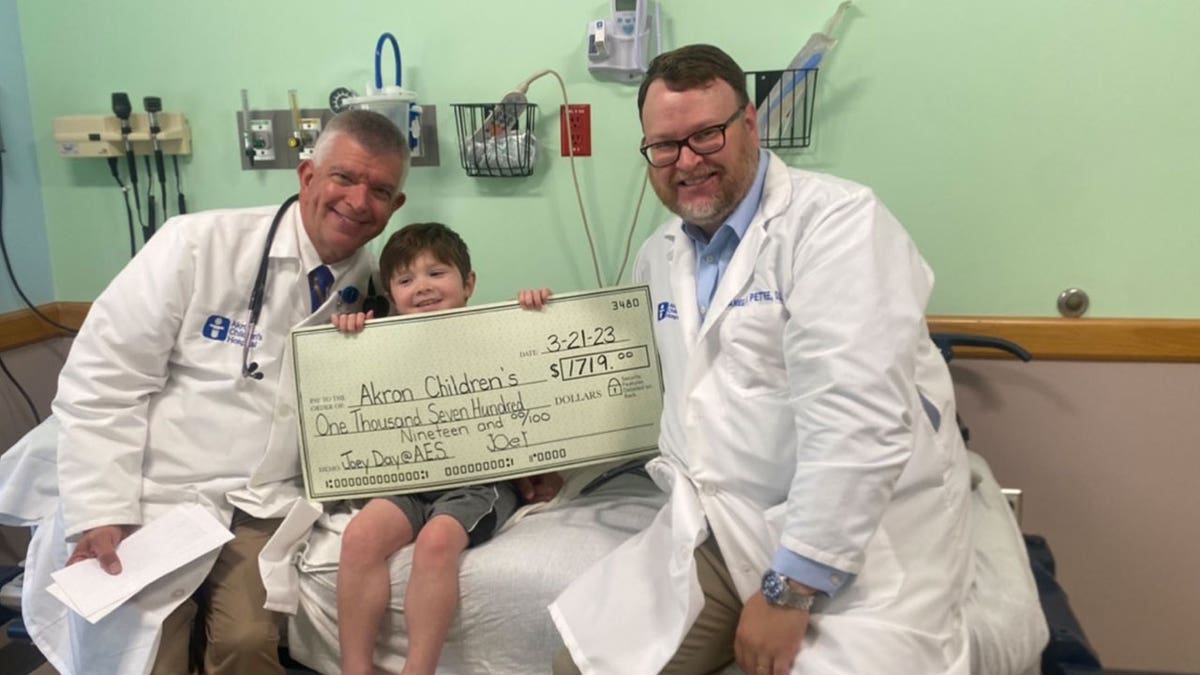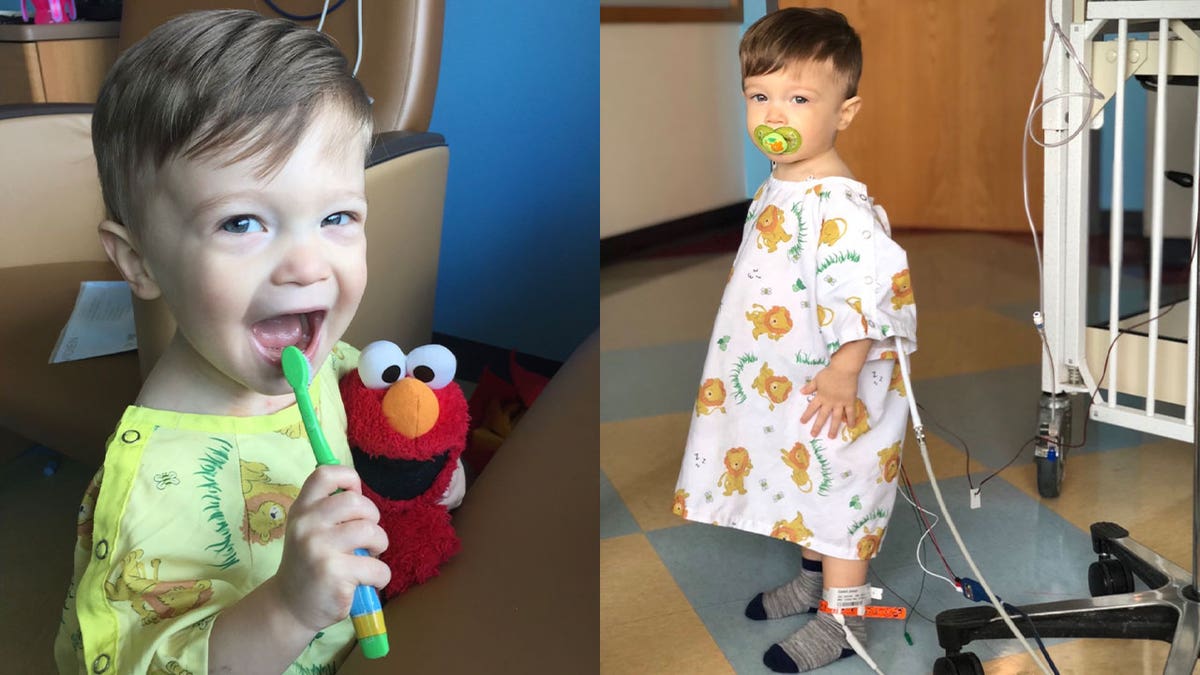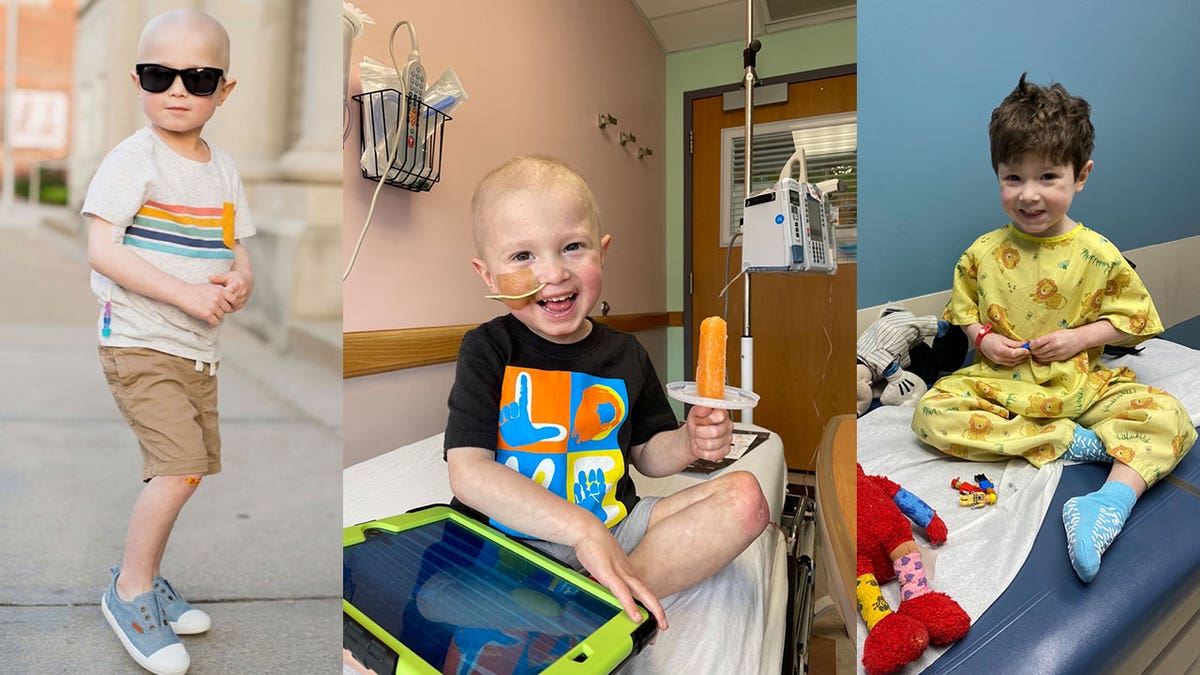Hoffman honors wife's memory by helping kids with cancer
Fox News contributor Dan Hoffman and his sons, Jerron and Nathan, discuss making "JoyJars" for children with cancer and supporting the Jessie Rees Foundation.
A cancer diagnosis for a child can be extremely difficult and feel unbearable to a family.
When a young child receives a diagnosis, families must navigate how to tell the child and other family members, plus handle treatment options and care for themselves and their child.
Having an age-appropriate conversation about the child's diagnosis could present challenges, especially as it's not a discussion a parent ever anticipates having. However, some parents find it more advantageous to be honest with their children, no matter their age.
"For us, we were very honest with him, and we always took that approach," Jessica Gaskell told Fox News Digital.
Gaskell's son, Joey Gaskell, was diagnosed with leukemia in October 2018 at 18 months old. The family is from Youngstown, Ohio. "He's very mature for his age in a lot of ways, and he understands a lot more than he should at six years old."
Read more on cancer diagnosis in children and young Joey Gaskell's journey to a cancer-free life.

Joey Gaskell is shown with doctors at Akron Children's Hospital. (Jessica Gaskell)
- What is the most common cancer in children?
- What are common symptoms of cancer in children?
- How common is cancer in children?
- How do you talk to a child about cancer?
- How do you help kids going through chemotherapy?
1. What is the most common cancer in children?
The most common cancers seen in children are leukemia, brain or spinal cord tumors, neuroblastoma, Wilms tumor, lymphoma, rhabdomyosarcoma, retinoblastoma and bone cancer, according to the American Cancer Society.
Childhood cancer, or pediatric cancer, occurs in children from the age of infancy up to 19 years old.
- Leukemia: Leukemia is the most common cancer found in children, according to the Cleveland Clinic. The two main types include acute lymphoblastic leukemia (ALL) and acute myeloid leukemia (AML).
- Lymphoma: Lymphoma is cancer found in the lymphatic system and includes two classes: Hodgkin's lymphoma and non-Hodgkin's lymphoma.
- Rhabdomyosarcoma: "It can occur anywhere in the body, but usually the head and neck, arms and legs, and urinary and reproductive organs," reads the Cleveland Clinic website of rhabdomyosarcoma, a rare type of cancer found in children.
- Neuroblastoma: Neuroblastoma is often found in very young children. It "starts in certain very early forms of nerve cells, most often found in an embryo or fetus," according to the American Cancer Society. Broken down, neuro refers to nerves and blastoma refers to cancer that starts in developing cells.
PROSTATE CANCER SYMPTOMS, WARNING SIGNS AND TREATMENT
- Retinoblastoma: Retinoblastoma is a very rare eye cancer found in children and can affect one or both eyes. Treatments for children can include cryotherapy, laser therapy, surgery and more.
- Osteosarcoma: Bone cancer – or osteosarcoma – can be looked at by doctors and specialists using X-rays, CT scans, PET and bone scans. Doctors may also biopsy for tissue samples.
- Wilms tumor: Wilms tumor – or nephroblastoma – is a rare kidney cancer found in young children, usually between ages 3-4.
- Brain tumors: Brain tumors are relatively rare but are the most common solid tumor in children. "Because of their location, some pediatric brain tumors and their required treatments can cause significant long-term impairment to intellectual and neurological function," according to Johns Hopkins Medicine's website.
- Spinal cord tumors: Spinal cord tumors are extremely rare in children.
2. What are the common symptoms of cancer in children?
A few common symptoms of cancer in children are an unusual lump or swelling, unexplained paleness, loss of energy, easy bruising or bleeding, prolonged pain in an area of the body, unexplained fever or ongoing illness, frequent headaches with vomiting, sudden eye or vision changes, and unexplained, sudden weight loss.
When it comes to a cancer diagnosis, it is typically discovered through imaging tests or a biopsy if there is an abnormal lump or tumor present.

Imaging tests are one way to detect cancer in the body. (iStock)
3. How common is cancer in children?
Cancer is not very common in children.
The American Cancer Society estimates that 9,910 children under the age of 15 will be diagnosed with cancer in 2023. Some 85% of those diagnosed will survive five years or more, according to the source, although survival rates depend on the type of cancer and a variety of other factors.
4. How do you talk to a child about cancer?
The process during a cancer diagnosis and treatment of a child will be an emotional time for families. In difficult moments like these, it's important to maintain open communication with your child and make sure their feelings are heard.

Joey Gaskell is shown after his leukemia diagnosis in 2018 at 18 months old. (Jessica Gaskell)
Typical treatment for the type of leukemia that Joey Gaskell battled is around two and a half years.
About two weeks before he completed treatment, doctors found that the boy had relapsed and required two more years of treatment.
On March 14, 2023, he rang the bell at Akron Children's Hospital in Ohio to signal his triumphant end to a long fight against cancer.
"He's really doing amazing," Jessica Gaskell said of her son. "He's not only surviving, he's thriving and finally getting to be a kid."
Gaskell found YouTube videos to be a helpful tool for explaining her son's diagnosis to him at such a young age.
"He was very curious about his cancer," Gaskell said.
"He's not only surviving, he's thriving and finally getting to be a kid."
One video, in particular, that she found helpful put cancer into simple analogies for children. Hemoglobin was explained as truck drivers driving oxygen through the blood. The video featured a police officer and construction worker likeness to explain the process of treating cancer to children.
Since his journey with his own treatment, he has lost friends to cancer. Gaskell chooses to remain honest and upfront with him during those conversations, too.
Prepare your child for treatment and the challenges they may face ahead. Reassure them that doctors, nurses, other medical staff and especially family members are caring for them around the clock. Additionally, talk about potential side effects of treatment and reassure your child illness does not mean the treatment isn't working.
CLICK HERE TO SIGN UP FOR OUR LIFESTYLE NEWSLETTER
A child with cancer will possibly spend long periods of time at the hospital. This setting away from home, parents, siblings and family pets can bring on nerves, stress, fears and feelings of isolation.

Joey Gaskell loved to play with Lego toys during his chemotherapy treatment for leukemia. (Jessica Gaskell)
"When he relapsed, we stayed for 30 days," Gaskell said. "That was our longest stay." Joey was usually in the hospital for 3-5 days during chemotherapy, but he did experience a 16-day stay during his treatment.
"Honestly, unfortunately, that's nothing compared to some kids."
Keep your child connected to friends and family through text messages, video calls and visits when it's safe for them to be around other people. Allow them to maintain connections to those around them, even when face-to-face contact is limited.
"We would not be able to do this without the amazing village that supported us the past five years," said Gaskell. Whether it be babysitting, financial assistance, meals, prayers, thoughts or good vibes, she advises parents with a sick child to accept the help and never be ashamed of it.
"It's only going to help. It's a hard battle," she said.
5. How do you help kids going through chemotherapy?
If your child is going through chemotherapy treatments, there are a number of ways to provide comfort.
Gaskell gave her son as many choices as she could during his treatment.
"He had beautiful, long hair when he relapsed," she said. Gaskell left the choice up to her son on whether he would shave it or keep it.
"He wanted it to fall out, and we let it fall out."
Additionally, bring items from home like a favorite blanket or pillow, a stuffed animal, photos from their bedroom or the living room, etc.
These comforting items can bring a sense of calm to a child during treatment. It can also give them an opportunity to talk about their favorite items with hospital staff or other people nearby. This may be a great way to occupy their mind for a little while.

The Gaskell family members are shown together here. (Jessica Gaskell)
During chemotherapy treatments, try to keep your child distracted as much as possible.
Bring toys, games, puzzles, movies, journals, tablets and all their favorite snacks to keep them busy while in the hospital.
"Lego was seriously his savior, I feel like, through this," Gaskell told Fox. "It takes up a lot of time in the hospital."
She also recommends arts and crafts but advises that activities are dependent upon how the child is feeling.
"Some days we'd sit and stare at him sleeping, not moving, not talking."
CLICK HERE TO GET THE FOX NEWS APP
Sitting still for treatment, especially for young children, may present challenges. Talk with doctors and nurses about whether the children can move around at all. If not, get an understanding for how other parents have kept their children still during treatment.
Gaskell credits the doctors and nurses at Akron Children's for some days being made a little less terrible.
"If they did get a spare minute, they would sit there and talk to us," she said.
For more Lifestyle articles, visit www.foxnews.com/lifestyle.



